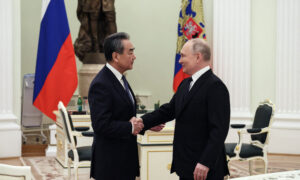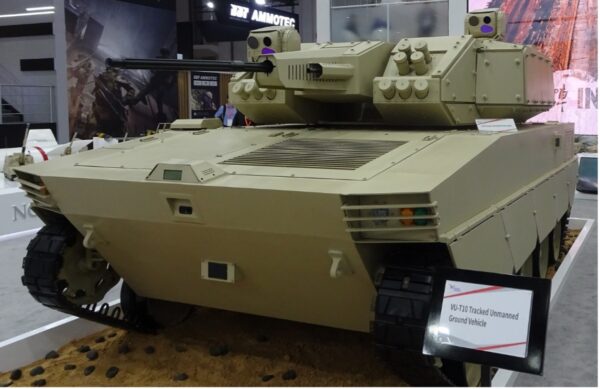China’s Potential to Aid Russia’s War in Ukraine
Commentary A quick survey of China’s well-stocked pavilions at the International Defense Exhibition (IDEX) in Abu Dhabi on Feb. 20–24 makes clear that China need only apply a fraction of its military-technical might to enable a Russian victory in Ukraine. The Biden administration is fearful this prospect is nigh. On Feb. 19, U.S. Secretary of State Antony Blinken warned that communist China is close to “crossing” the line and providing lethal aid to help Russia’s war with Ukraine. In a Feb. 2 report, The Wall Street Journal, with the help of the C4ADS think tank, reviewed Russian customs records revealing that China has shipped back to Russia parts for Mi-8/17 medium helicopters, parts for the radar for S-300 fourth-generation anti-aircraft missiles, and parts for the Sukhoi Su-35 four-plus generation fighter jet. China’s well of “sales returns” that Russia could access is much deeper: over 1,000 of the anti-aircraft with some anti-missile capability Almaz Antey fourth and four-plus generation S-300 and S-400 missiles that will deal handily with future transfers of U.S. F-16 fighters to Ukraine, and about 300 workhorse Mi-8/17 helicopters that would revive Russian deep offensive operations. But with an eye on Russia, China, and his upcoming reckoning in the U.S. House of Representatives, President Joe Biden carefully marshaled his Feb. 20 “surprise” visit to Kyiv to show U.S. support amid the first anniversary of Russia’s invasion of Ukraine—with Russia on the verge of another massive offensive. Biden declared: “Ukraine stands. Democracy stands. The Americans stand with you, and the world stands with you.” He also promised $500 million in new U.S. military aid in addition to $27 billion in American military aid since February 2022, bringing the total to $120 billion from U.S. allies and partners. What does it mean if China “stands with Russia” with the same intensity? A stark warning of China’s potential to arm Russia was on display at IDEX. China produces and could immediately ship vast stocks of Russian caliber weapons, from 152- and 122-millimeter artillery shells, and 125- and 100-mm tank rounds and tank-fired guided missiles to 122- and 300-mm unguided and precision-guided artillery rockets. Reflecting the IDEX show’s dominant theme of unmanned combat systems, Chinese arms concerns offered a plethora of unmanned aircraft, unmanned small helicopters, loitering munitions, and unmanned ground vehicles—all for combat missions. These could help Russia revive its stalled offensive by enabling better precision for artillery and mortar strikes, and reducing horrific Russian casualties that may exceed 200,000 troops. Ground force weapons producer Norinco prominently displayed its VU-T10 30-mm cannon-armed unmanned “tank” that could provide battlefield advantage without wasting more soldiers’ lives. Norinco displays its VU-T10 unmanned 30-mm cannon-armed “tank” at IDEX, a system that could help Russian offensives and reduce Russian casualties, in Abu Dhabi, United Arab Emirates, in February 2023. (Courtesy of Richard Fisher) Just as important, Chinese companies like Norinco and Poly can offer five different 50- to 10-kilowatt laser weapons that—combined with their radar, optical, and computer-controlled command systems—can slap down Ukraine’s dominant use of drones against Russia. Chinese export model tanks like the Norinco VT-4 are armed with 125-mm cannon-launched anti-tank missiles. Still, they are also equipped with an Active Defense System that could take out Western anti-tank missiles like the much-vaunted U.S. Javelin, which during the last year has crushed Russian armor in Ukraine. Even though Beijing feigned “opposition” to Moscow’s invasion of Ukraine in early 2022, it was inevitable that China would become a supplier to Russian leader Vladimir Putin’s ambition to suborn Europe through a revival of the Warsaw Pact domination of the Soviet era. A Feb. 24 Chinese “peace proposal” for Ukraine clearly favors Russia by allowing it to keep occupied Ukrainian territory and proposes a “ceasefire” and “demilitarized zone” that would favor future Russian offensives. Norinco could also offer Russia its 2.4-mile range HJ-12 anti-tank guided weapon (top) similar to the U.S. Javelin, or its 3.1-mile range GP125 tank-launched anti-tank missile. (Courtesy of Richard Fisher) It is possible that Russia and China would coordinate, with China waiting a year before starting massive military aid to better tip the balance of power against a near-exhausted Ukraine. The Chinese Communist Party (CCP) requires a Russian “victory,” whatever that means, to ensure Moscow’s participation in its looming invasion of Taiwan, which both have been preparing for in many land, air, and sea military exercises. Beijing must also bring about the defeat of the U.S. and NATO/partner coalition, not just to deter a similar coalition template that may spring into action to aid Taiwan, but also to validate the CCP’s power to

Commentary
A quick survey of China’s well-stocked pavilions at the International Defense Exhibition (IDEX) in Abu Dhabi on Feb. 20–24 makes clear that China need only apply a fraction of its military-technical might to enable a Russian victory in Ukraine.
The Biden administration is fearful this prospect is nigh. On Feb. 19, U.S. Secretary of State Antony Blinken warned that communist China is close to “crossing” the line and providing lethal aid to help Russia’s war with Ukraine.
In a Feb. 2 report, The Wall Street Journal, with the help of the C4ADS think tank, reviewed Russian customs records revealing that China has shipped back to Russia parts for Mi-8/17 medium helicopters, parts for the radar for S-300 fourth-generation anti-aircraft missiles, and parts for the Sukhoi Su-35 four-plus generation fighter jet.
China’s well of “sales returns” that Russia could access is much deeper: over 1,000 of the anti-aircraft with some anti-missile capability Almaz Antey fourth and four-plus generation S-300 and S-400 missiles that will deal handily with future transfers of U.S. F-16 fighters to Ukraine, and about 300 workhorse Mi-8/17 helicopters that would revive Russian deep offensive operations.
But with an eye on Russia, China, and his upcoming reckoning in the U.S. House of Representatives, President Joe Biden carefully marshaled his Feb. 20 “surprise” visit to Kyiv to show U.S. support amid the first anniversary of Russia’s invasion of Ukraine—with Russia on the verge of another massive offensive.
Biden declared: “Ukraine stands. Democracy stands. The Americans stand with you, and the world stands with you.”
He also promised $500 million in new U.S. military aid in addition to $27 billion in American military aid since February 2022, bringing the total to $120 billion from U.S. allies and partners.
What does it mean if China “stands with Russia” with the same intensity?
A stark warning of China’s potential to arm Russia was on display at IDEX.
China produces and could immediately ship vast stocks of Russian caliber weapons, from 152- and 122-millimeter artillery shells, and 125- and 100-mm tank rounds and tank-fired guided missiles to 122- and 300-mm unguided and precision-guided artillery rockets.
Reflecting the IDEX show’s dominant theme of unmanned combat systems, Chinese arms concerns offered a plethora of unmanned aircraft, unmanned small helicopters, loitering munitions, and unmanned ground vehicles—all for combat missions.
These could help Russia revive its stalled offensive by enabling better precision for artillery and mortar strikes, and reducing horrific Russian casualties that may exceed 200,000 troops.
Ground force weapons producer Norinco prominently displayed its VU-T10 30-mm cannon-armed unmanned “tank” that could provide battlefield advantage without wasting more soldiers’ lives.

Just as important, Chinese companies like Norinco and Poly can offer five different 50- to 10-kilowatt laser weapons that—combined with their radar, optical, and computer-controlled command systems—can slap down Ukraine’s dominant use of drones against Russia.
Chinese export model tanks like the Norinco VT-4 are armed with 125-mm cannon-launched anti-tank missiles. Still, they are also equipped with an Active Defense System that could take out Western anti-tank missiles like the much-vaunted U.S. Javelin, which during the last year has crushed Russian armor in Ukraine.
Even though Beijing feigned “opposition” to Moscow’s invasion of Ukraine in early 2022, it was inevitable that China would become a supplier to Russian leader Vladimir Putin’s ambition to suborn Europe through a revival of the Warsaw Pact domination of the Soviet era.
A Feb. 24 Chinese “peace proposal” for Ukraine clearly favors Russia by allowing it to keep occupied Ukrainian territory and proposes a “ceasefire” and “demilitarized zone” that would favor future Russian offensives

It is possible that Russia and China would coordinate, with China waiting a year before starting massive military aid to better tip the balance of power against a near-exhausted Ukraine.
The Chinese Communist Party (CCP) requires a Russian “victory,” whatever that means, to ensure Moscow’s participation in its looming invasion of Taiwan, which both have been preparing for in many land, air, and sea military exercises.
Beijing must also bring about the defeat of the U.S. and NATO/partner coalition, not just to deter a similar coalition template that may spring into action to aid Taiwan, but also to validate the CCP’s power to lead and protect its growing military network of largely authoritarian states centered in the growing Shanghai Cooperation Organization and BRICS coalitions.
But by ensuring Russia’s “victory” over Ukraine, the CCP goes far to achieve another goal: establishing the perverse “moral imperative” for the CCP-Russia dictatorship complex to contain and diminish all other democracies.

If his leadership rallies America’s allies and helps produce an eventual Ukrainian victory, Biden’s surprise visit to Kyiv may be viewed as his “finest hour,” provided Biden is willing to give heretofore denied weapons like fourth-generation combat aircraft and short-range ballistic missiles that can attack deep Russian logistic and command nodes.
But if his visits and additional weapons give the CCP the excuse it seeks to go all-in for providing arms and munitions for Russia, Biden’s visit may be seen as the beginning of a new turn, a longer-term global conflict characterized by coordinated Chinese and Russian assaults on the democracies, starting with a second major war over Taiwan.
To arrest such a turn, the Biden administration must start by building up U.S. nuclear weapons, as China and Russia are increasing their strategic and regional nuclear forces to coerce the United States from assisting its allies and partners.
Like Putin, the United States should “suspend” its adherence to former President Barack Obama’s 2010 New START strategic arms limitation treaty and replace over 3,000 nuclear warheads removed from U.S. strategic missiles to comply with that treaty.
Biden must also order the crash production of new U.S. theater nuclear weapons for cruise and ballistic missiles to deter Russia and China from using their superior theater nuclear forces.
The alternative could entail the United States “fighting” two wars in 2023 and the Pentagon pressing for a revival of the draft.
Views expressed in this article are the opinions of the author and do not necessarily reflect the views of The Epoch Times.












